Soft, light and spongy which is everything a cooker cake should be! This decadent eggless cooker cake recipe is easy to make and can be prepared in a stove-top pressure cooker. Serve it as a dessert and feel free to frost the sponge cake with any icing of your choice.
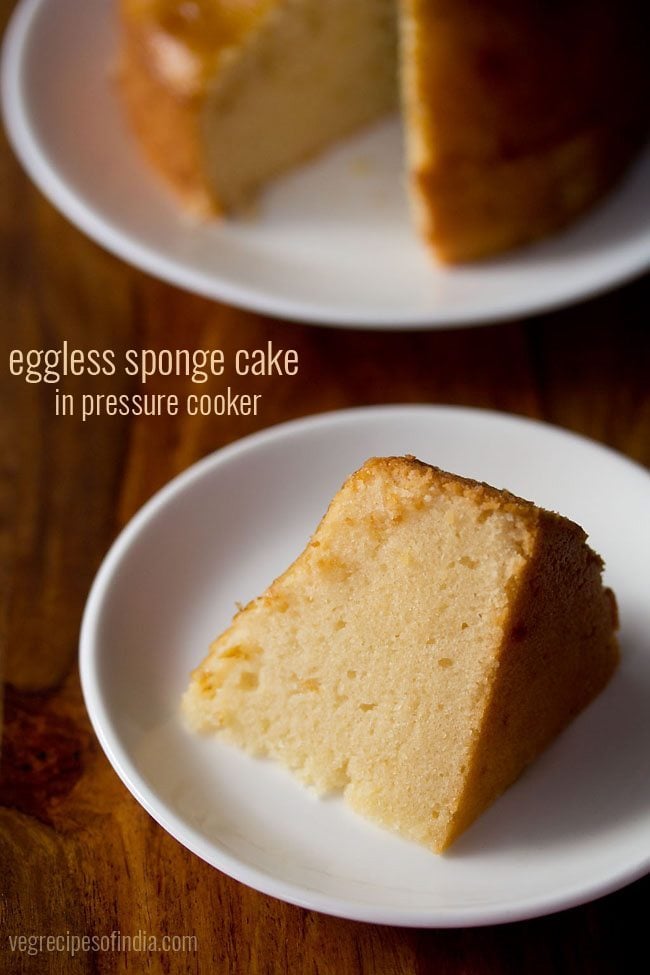
Table of Contents
About Cooker Cake
Making a basic cake in a pressure cooker is easy. This is an easy, eggless and spongy cake recipe with no beating or whipping required.
My wheat cake recipe inspired this recipe. I have used all-purpose flour (maida) to prepare the cake but, you can also make it with whole wheat flour (atta).
If you want to make a wheat cake in the pressure cooker, then check out my Wheat Cake recipe. Make the batter and follow the method below to bake the cake in a pressure cooker. I have also shared recipe of Pressure Cooker Chocolate Cake.
This recipe yields a small sponge cake enough for a family of 3 or 4. This cake usually disappears as soon as I make it but, If there are any leftovers then it can be stored in the refrigerator. The recipe can also be doubled too.
Serve the pressure cooker cake warm or at room temperature. If you want, you can also frost the cake with any icing of your choice.
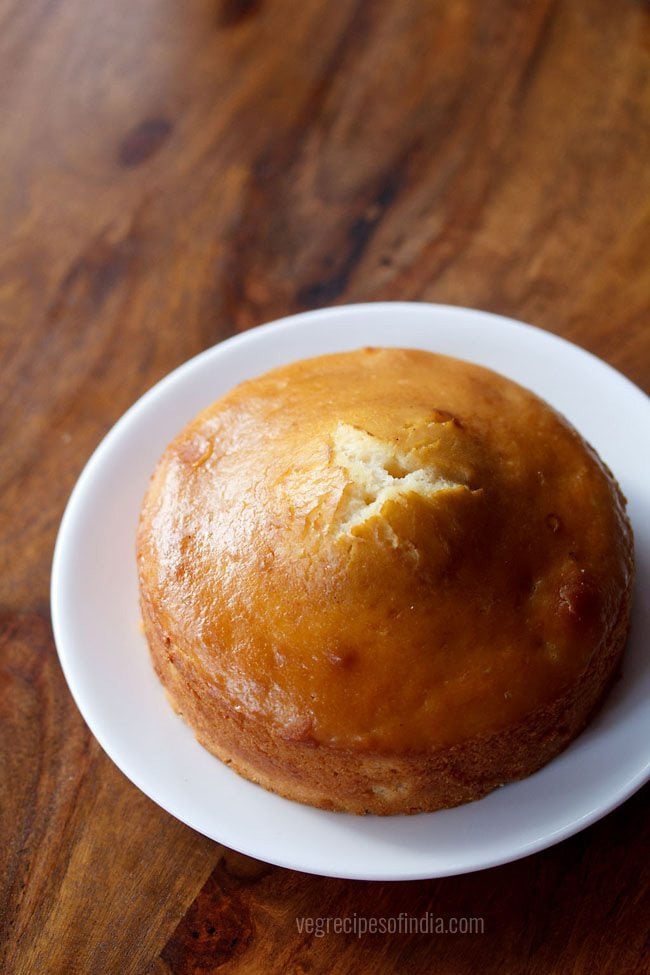
Do’s and Don’ts for Cooker Cake
- Pressure cooker: Use a good quality, heavy and thick bottomed 5 to 6-liter stovetop aluminum cooker for this cooker cake recipe. Use this cooker for baking only. Do not use this cooker for pressure cooking or boiling or steaming as the metal weakens if you continue to bake in the cooker. I would not recommend using a steel, anodized or a nonstick pressure cooker.
- Baking cake: Always use sea salt or river sand as a layer between the pressure cooker and pan. You can use the same salt for your next round of baking too. This first layer of salt help in even baking and does not overheat your baking pan which may cause the cake to burn or have brown spots at the bottom.
- Gasket and vent weight: Also, make sure you remove the gasket (rubber ring) and the vent weight (whistle) from the lid when you use your pressure cooker for baking.
- Trivet or rack: I also recommend to place a heatproof rack or trivet with a small height on the layer of salt inside the cooker. This rack or trivet acts as a second layer and makes sure that the cake is baked evenly without any burnt spots at the bottom.
- Flame: Make sure you cook the cake on a low heat or a medium-low heat to ensure that you get a fluffy and moist sponge.
- Cake pan: The pan used inside the cooker should be able to take dry heat. I used a regular round aluminum cake pan. Avoid using steel pans as the cake might get burnt from the bottom.
- Fit: Before you start cooking, make sure you check whether the baking pan will fit inside the pressure cooker first. If it doesn’t fit then use a smaller tin.
- Cleaning and care: Let the cooker cool completely first at room temperature. Then remove the salt which can be used again while baking cake in a cooker the next time. Store this salt in a container. Before you rinse or wash the cooker, ensure it is not hot. Clean the cooker and its lid with your preferred dish wash cleaner. Rinse thoroughly in water. Wipe dry and set aside.
How to Make Cake in Cooker
Prep
1. First grease a 5.5 inch (diameter) and 2.75 inches (height) pan very well with some butter. Set aside for later. You can also use a 6×6 inch square pan or a 5 inch round pan.
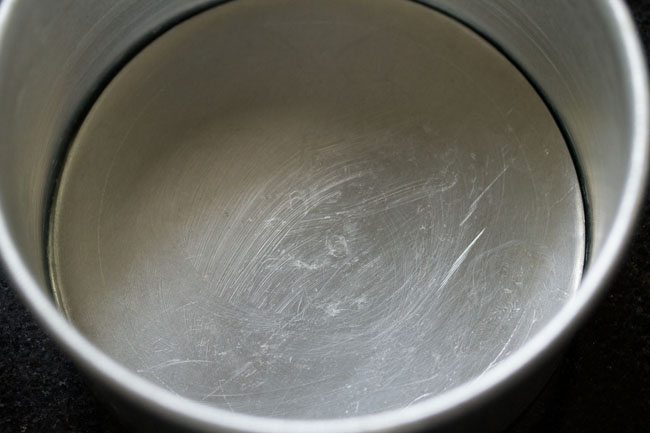
2. Place a mixing bowl beneath a sieve. Add 1 cup of all-purpose flour and ½ a teaspoon of baking powder to a sieve. If using unsalted butter, then add a light pinch of salt to the flour.
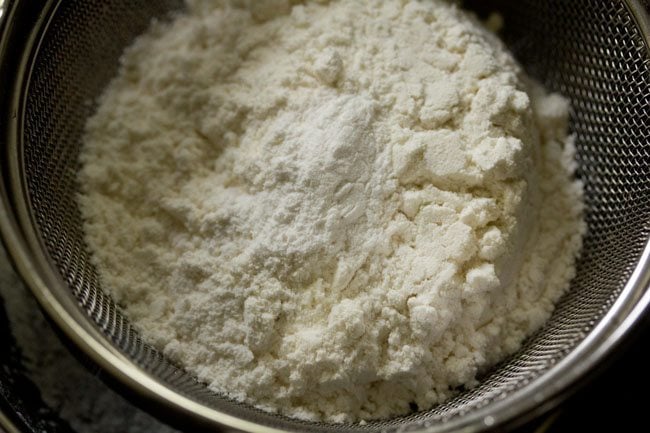
3. Sift once.

4. Sprinkle 1 teaspoon of vanilla extract or ½ a teaspoon of vanilla essence all over the flour. You can also add vanilla extract later after mixing the batter.

5. Take a 5 to 6 litre pressure cooker. Remove the gasket (rubber ring) from the lid and remove the vent weight (whistle).
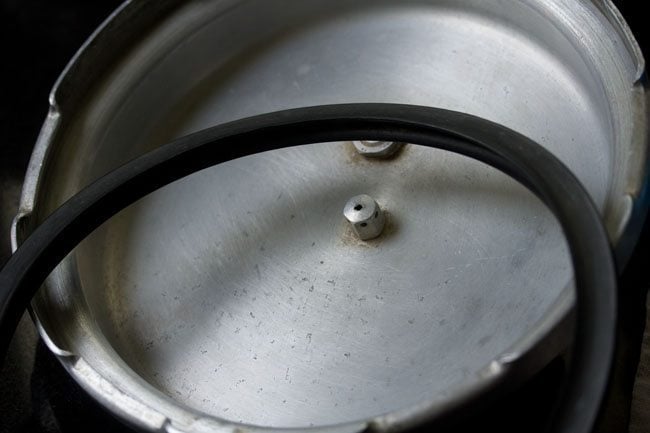
6. Now take your pressure cooker. It is best to use a 5 or 6 liter heavy aluminium cooker.

7. Add 1 cup of sea salt into the cooker and spread the sea salt evenly in one single layer inside the cooker. You can also use river sand in place of salt.

19. Carefully keep a heatproof stand or rack or trivet on the layer of salt inside the pressure cooker. Keep the flame to a low and begin to preheat the pressure cooker for 5 minutes.
Remember to keep the heat to its lowest while preheating the cooker.
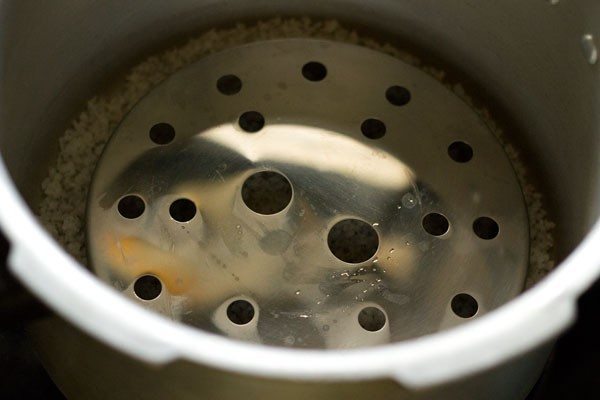
Make Batter
8. Meanwhile add ¼ cup of salted butter (40 grams) to a separate pan.
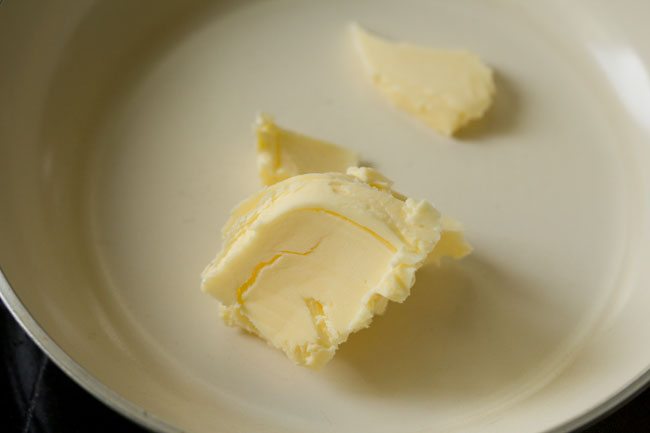
9. Now add ½ a cup of condensed milk to the pan.
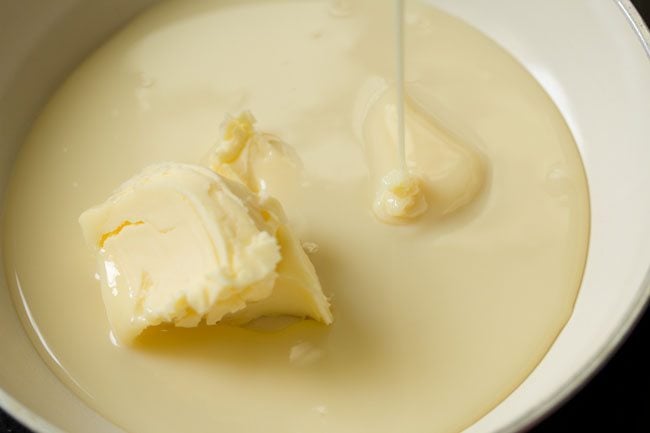
10. Add 3 tablespoons of sugar. I used organic unrefined cane sugar but, you can also use regular sugar.

11. Add ½ cup of water.
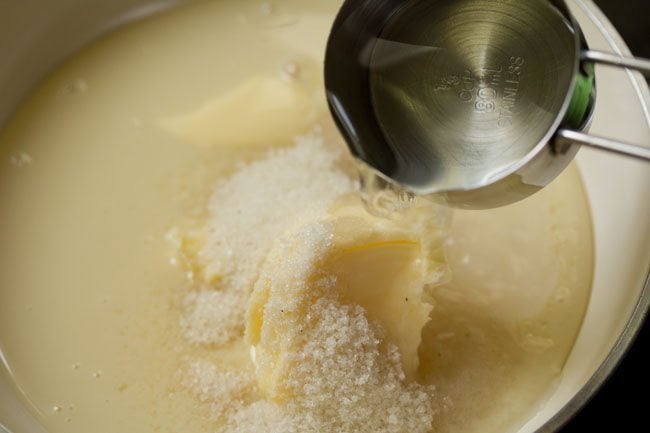
12. Place the pan on stovetop and heat this mixture on a low flame.
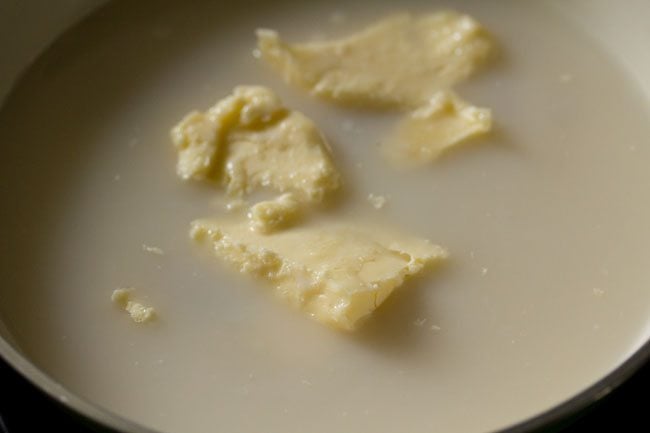
13. Stir with a spatula so that the butter melts. Mix everything until well combined with a spatula.
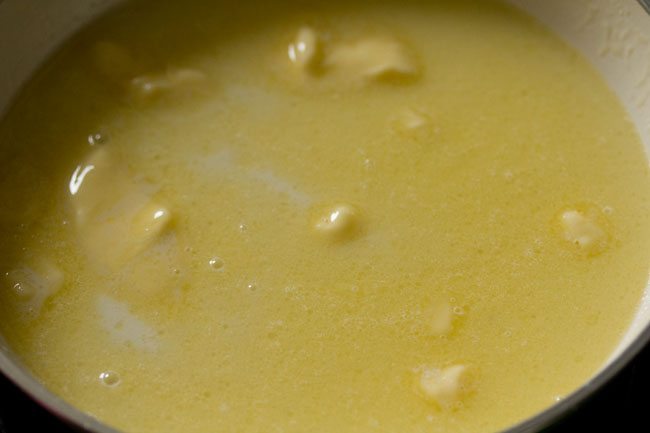
14. Let this mixture come to a gentle simmer on a low heat.
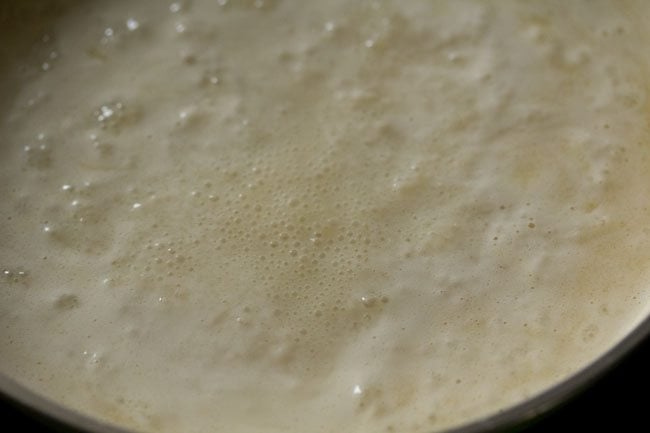
15. Once this mixture comes to a gentle simmer then immediately add it in the flour mixture.
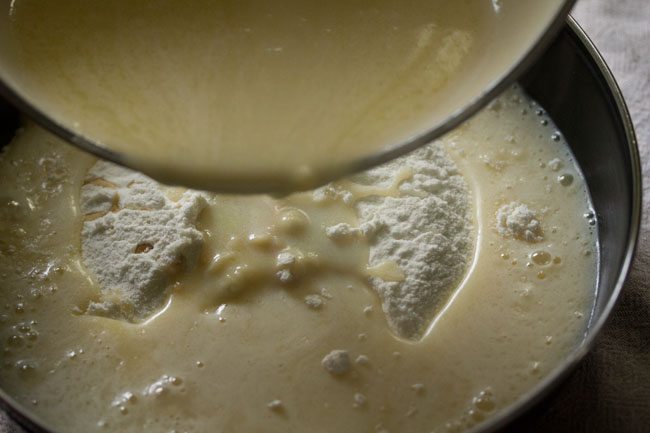
16. Grab a wire whisk and mix gently to prevent overmixing from happening. While mixing you will see whether the batter is too thick or thin. The batter should have a medium consistency.
You may need to add less or more water. If the batter is too thick then add ¼ cup of hot water. So keep some hot water handy.

17. Whisk until you get a smooth batter but, don’t over mix the batter. If you see some small tiny lumps in the batter, then let them be.

18. Pour the batter in the pan and gently shake the pan or tap the sides.
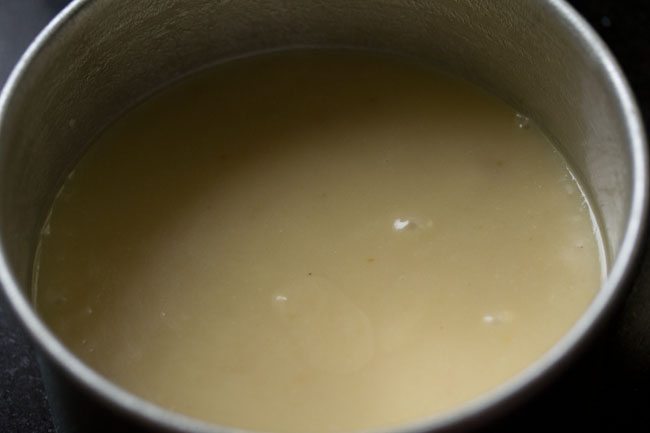
Make Cooker Cake
20. Hold the pan with a pair of tongs or use oven mitts and carefully place the cake pan on top of the rack or trivet in the cooker.
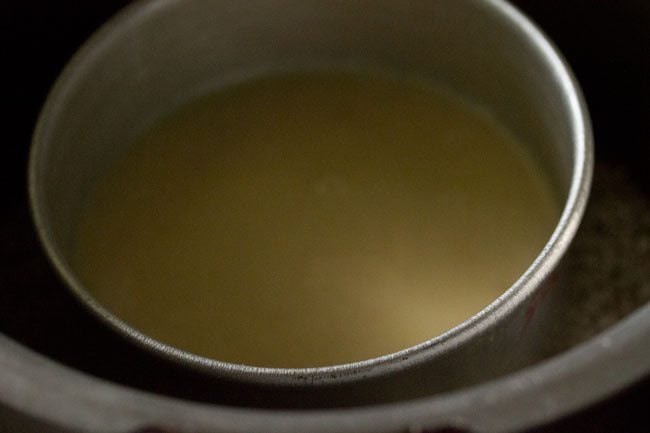
21. Secure the lid firmly and tightly on the cooker. Make sure you remember to remove the vent weight (whistle).

22. Bake the sponge cake on a low heat or sim until the cake turns golden. It takes about 40 to 50 minutes for the cake to bake in a 5-liter pressure cooker.
Cook the cake for 35 minutes to 50 minutes depending on the size of the cooker, the size and quality of the cake pan and the intensity of the heat.
Check the cooker cake by switching off the heat and removing the lid. Be careful as the cooker will be very hot.
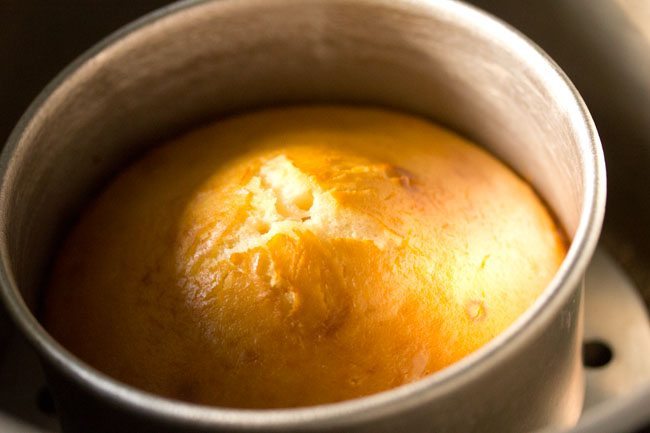
23. The top should be golden and when you insert a bamboo skewer in the center of the cake, it should come out clean or with a few cake crumbs. However, if the skewer is sticky and has cake batter on it then it is not ready.
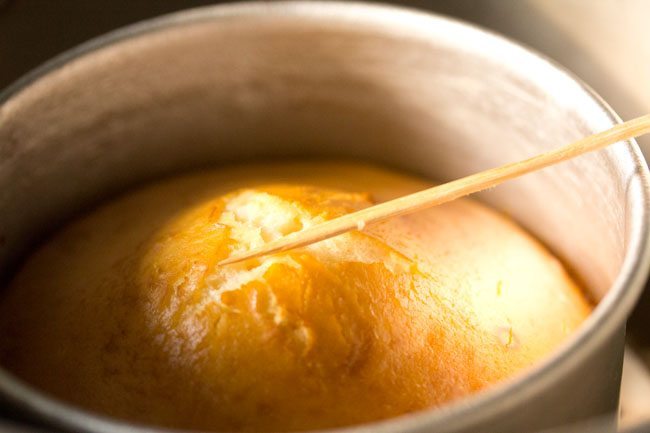
24. With the help of tongs remove the cake pan and place it on a wired rack. Allow the cake to become warm or cool at room temperature. Then remove the cake gently from the mould.

25. Serve the cooker cake warm or at room temperature. If you want you can also frost the cooker cake with any icing of your choice. Refrigerate the leftovers.

FAQs
Yes, you can use a pressure cooker to bake desserts like cakes, puddings or cupcakes. Mix your favorite cake batter together and pour it into a prepared pan that fits into your pressure cooker.
It is vital and important that you do NOT add any water to the pressure cooker while the cake is baking. Water will steam the cake instead of baking.
Yes, you can bake this eggless sponge cake in an oven. Preheat the oven for at least 15 minutes at 180 degrees Celsius/356 degrees Fahrenheit and bake for 30 to 35 minutes or until the crust is golden.
More Delicious Cakes To Try!
If you’ve tried this recipe, please rate it in the recipe card or leave a comment below – I’d love to hear your feedback. For more vegetarian inspiration, sign up for my email updates or follow me on Instagram, Youtube, Facebook, Pinterest or X.

Cooker Cake | Eggless Pressure Cooker Cake
Equipment
- 5 to 6 liter stovetop pressure cooker
- 1 cup sea salt
- 1 small baking pan
- 1 small heatproof trivet or stand or rack
Ingredients
Dry ingredients to be sifted
- 1 cup all purpose flour – 125 grams
- ½ teaspoon baking powder
Wet ingredient
- 1 teaspoon vanilla extract or ½ teaspoon vanilla essence
For the butter+condensed milk mixture
- ¼ cup salted butter – 40 grams, you can also use unsalted butter
- ½ cup sweetened condensed milk
- 3 tablespoons sugar
- ½ cup water
Instructions
Preparation
- First grease a 5.5 inches (diameter) and 2.75 inches (height) pan very well with some butter. Keep aside.
- Place a mixing bowl beneath a sieve. Add all purpose flour and teaspoon baking powder in the sieve. If using unsalted butter, then you can add a light pinch of salt in the flour. Sift once.
- Sprinkle vanilla extract or vanilla essence all over the flour. You can also choose to add vanilla extract later after mixing the batter.
- Take a 5 to 6 litre pressure cooker. Remove the gasket (rubber ring) from the lid. Also remove the vent weight (whistle) from the lid.
- Now take the cooker and spread 1 cup of sea salt evenly all over the bottom in one single layer.
- Keep a heat proof stand or wired rack or trivet on the layer of salt inside the cooker.
- Begin to heat the cooker on a low flame on a stovetop. Keep the heat to its lowest and preheat for 5 minutes.
Making batter
- Meanwhile, in a pan, take salted butter, sweetened condensed milk, sugar and water. I used raw sugar. You can also use white sugar.
- Place the pan on stovetop and heat this mixture on a low flame.
- Stir with a spatula so that the butter melts. Mix everything very well with the spatula.
- Let this mixture come to a gentle simmer on a low heat.
- When this mixture comes to a gentle simmer, then immediately add it in the flour mixture.
- With a wired whisk begin to mix with a light pressure, so that over mixing does not happen.
- While mixing you will come to know if the batter is going to be thick or too thick. The batter in this recipe is of medium consistency – neither thick nor thin.
- Depending on the quality of flour, you may need to add less or more water. If the batter becomes thick, then do add ¼ cup more hot water. So do keep some hot water handy.
- Whisk to a smooth batter, but don’t over do the mixing. If there are small tiny lumps in the batter, then its fine.
- Now pour the batter in the pan. Gently shake the pan or tap the sides.
Making cooker cake
- Place the cake pan carefully in the cooker holding the pan with a pair of tongs or using oven mitts.
- Secure the lid firmly and tightly on the cooker. Do remember to remove the vent weight (whistle).
- Bake sponge cake on a low flame or sim, till the cake turns golden. It took about 50 minutes for the cake to bake in the 5 litre pressure cooker I used.
- So consider an average time of 35 minutes to 50 minutes, depending on the size of the cooker, the size and quality of the cake pan and the intensity of the flame.
- You can check the cake by switching off the heat and removing the lid. Take care as the cooker will be very hot.
- The top should be golden and when you insert a bamboo skewer in the center of the cooker cake, it should come out clean or with a few cake crumbs, with no sticky batter on it.
- Remove the cake pan carefully by holding it with a pair of tongs as the cooker will be very hot.
- Place the cake pan on a wired tray to cool. Let the cake become warm or cool at room temperature.
- Then remove the cake gently from the mould. Serve cooker cake warm or at room temperature. If you want, you can also frost the cake with any icing of your choice. Refrigerate the leftovers.
Notes
- Use a heavy 5 to 6 liter aluminium cooker and keep this cooker for baking only.
- Remember to remove the gasket (rubber ring) and vent weight (whistle) from the lid when you use the pressure cooker for baking.
- While baking, keep a low to medium-low heat. Note that the timing of baking will vary with the size, heaviness, weight of the stovetop pressure cooker and the volume of the batter.
- You can also use unsalted butter. If using unsalted butter, then add a pinch of salt while sifting the flour.
- Substitute for butter is ¼ cup oil. You can use a neutral flavored oil like sunflower oil or even olive oil can be used.
- Ghee can also be used instead of butter.
- Note that the approximate nutrition info is for 1 thick slice of the cooker cake.
Nutrition Info (Approximate Values)
This cooker cake post from the archives, first published on October 2016 has been republished and updated on 11 November 2021.



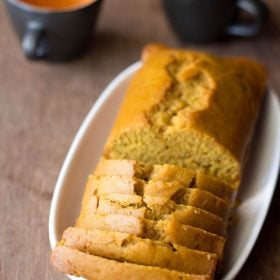









Tried your eggless banana cake in my stainless steel pressure cooker. Alas! I had not read your post completely and missed the point of not using steel cooker. It reacted with the salt. Cooker and cake gone.
Oh no! I am sorry to know about this. I always suggest our blog readers to read the entire recipe or post before starting. It helps avoid mishaps like this one. I hope your next baking attempt will be a successful one.